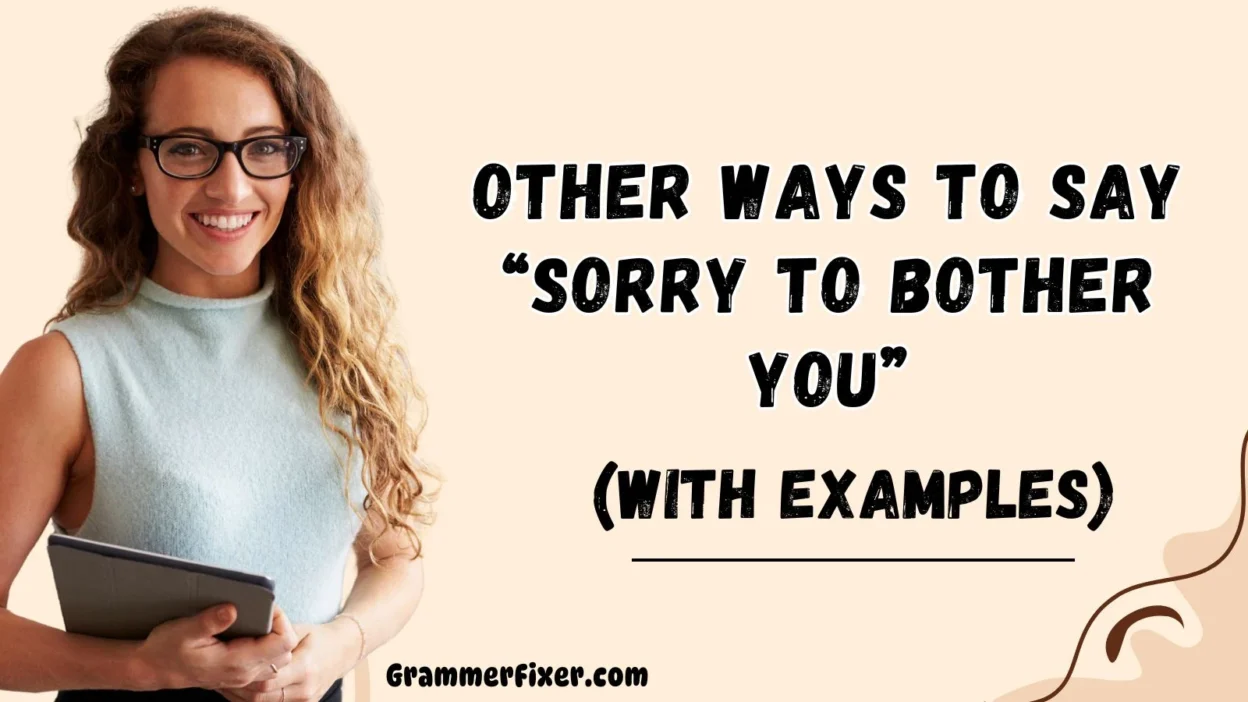In both professional and casual communication, finding the right words can make all the difference. Saying “Sorry to bother you” is a courteous phrase meant to show empathy, respect, and mindfulness—but it can feel overused or overly apologetic.
Whether you’re reaching out to a colleague, manager, or client, using thoughtful alternatives helps express yourself clearly and sincerely—while maintaining a polite tone and positive impression.
Below are 30 meaningful alternatives that combine warmth, professionalism, and linguistic variation to suit different contexts.
What Does “Sorry to Bother You” Mean?
The phrase “Sorry to bother you” is a courteous expression used when someone is about to interrupt, ask a question, or request assistance—especially when the other person may be busy.
It shows an awareness of the other person’s time, attention, or situation and attempts to be respectful in tone.
Is It Professional/Polite to Say “Sorry to Bother You”?
Yes, it’s generally considered polite and professional—but in excess, it can come across as overly apologetic, insincere, or even undermining your confidence.
Choosing the right variation based on context can reinforce respect, purpose, and clarity in your message without excessive self-blame.
Advantages or Disadvantages of Saying “Sorry to Bother You”
Advantages:
- Demonstrates consideration and politeness
- Acknowledges the recipient’s time and attention
- Helps ease into unscheduled or unexpected conversations
Disadvantages:
- Can feel repetitive or passive
- Might suggest hesitation, lack of confidence, or even guilt
- Risks sounding like a formality if not paired with context
1. Excuse Me
Meaning: A polite phrase used to gain someone’s attention or politely interrupt.
Explanation: Often used in both spoken and written form, this phrase is direct yet respectful.
Scenario Example:
“Excuse me, do you have a moment to review the proposal draft before tomorrow’s deadline?”
Best Use: Professional or casual settings when you need to interrupt briefly or request something.
Tone: Polite, neutral, respectful
2. Pardon Me
Meaning: A gentle way of interrupting or requesting attention, slightly more formal than “Excuse me.”
Explanation: Useful when entering an ongoing conversation or approaching someone respectfully.
Scenario Example:
“Pardon me for reaching out late in the day, but I wanted to confirm the meeting schedule.”
Best Use: Emails, meetings, formal settings
Tone: Formal, refined, soft-spoken
3. I Hope I’m Not Interrupting
Meaning: A way to acknowledge potential disruption before delivering a message.
Explanation: Shows awareness and consideration of the recipient’s current focus or workload.
Scenario Example:
“I hope I’m not interrupting your day, but I wanted to quickly follow up on the client feedback.”
Best Use: When you suspect the person may be busy or involved in something else.
Tone: Empathetic, sincere, respectful
4. Forgive My Intrusion
Meaning: A formal and deeply respectful way to apologize for interrupting.
Explanation: Ideal for sensitive situations where a high level of respect and humility is needed.
Scenario Example:
“Forgive my intrusion—I understand your schedule is full, but this is time-sensitive.”
Best Use: High-stakes or executive communication, or during urgent requests
Tone: Formal, humble, apologetic
5. Apologies for the Interruption
Meaning: A more formal variation of “Sorry to bother you.”
Explanation: This phrase works well in written emails or presentations when you need to pause or shift focus.
Scenario Example:
“Apologies for the interruption—just a quick clarification about the client brief.”
Best Use: Meetings, presentations, and emails
Tone: Professional, polished, considerate
6. I Regret Disturbing You
Meaning: A soft, sincere way of saying that you’re aware your message might not be perfectly timed.
Explanation: Suitable when contacting someone outside of normal hours or during their off-time.
Scenario Example:
“I regret disturbing you on your day off, but the client’s request is urgent.”
Best Use: Time-sensitive communications outside of regular work hours
Tone: Formal, deeply considerate
7. I Didn’t Mean to Trouble You
Meaning: A classic phrase to express apology for an unintended disturbance.
Explanation: Softens the tone when you’re following up or asking for assistance again.
Scenario Example:
“I didn’t mean to trouble you again, but I’m still waiting on feedback for the revised draft.”
Best Use: Follow-up messages or repeated communication
Tone: Gentle, apologetic, friendly
8. Just a Quick Question
Meaning: A polite way to signal a brief, low-impact inquiry.
Explanation: Helps set expectations that you won’t take up much time.
Scenario Example:
“Just a quick question—do we have the finalized budget for Q3?”
Best Use: Time-conscious environments or busy colleagues
Tone: Concise, light, respectful
9. Hope This Isn’t an Inconvenience
Meaning: Signals awareness that the message may be disruptive.
Explanation: Emphasizes consideration while also validating the urgency of your communication.
Scenario Example:
“Hope this isn’t an inconvenience—I wanted to align on the updated campaign schedule.”
Best Use: Email follow-ups or urgent clarifications
Tone: Respectful, empathetic
10. If You’re Not Too Busy
Meaning: A tactful way to ensure the person has capacity before proceeding.
Explanation: Great for easing into a message when you’re unsure of their workload.
Scenario Example:
“If you’re not too busy, would you mind reviewing the attached brief?”
Best Use: When dealing with colleagues who handle multiple priorities
Tone: Courteous, non-intrusive
11. I’ll Keep This Brief
Meaning: A respectful way to indicate that the message will be short and to the point.
Explanation: Assures the recipient that their time is valued, especially during a busy day.
Scenario Example:
“I’ll keep this brief—I just need your approval on the updated timeline.”
Best Use: When addressing time-sensitive issues with minimal explanation needed.
Tone: Respectful, direct, efficient
12. I Appreciate Your Time
Meaning: A phrase that expresses gratitude for the recipient’s attention or effort.
Explanation: Rather than apologizing, it focuses on acknowledging their help and being thankful.
Scenario Example:
“I appreciate your time—your feedback will help improve the final proposal.”
Best Use: In follow-up or collaborative communication
Tone: Grateful, positive, professional
13. Not to Take Up Too Much of Your Time
Meaning: A polite way of prefacing a message by respecting someone’s schedule.
Explanation: Sets a respectful tone and reassures that the message won’t be burdensome.
Scenario Example:
“Not to take up too much of your time, but I wanted to ask about the project timeline.”
Best Use: Client communication, managerial check-ins
Tone: Polite, humble, respectful
14. Just Wanted to Reach Out
Meaning: A light and friendly introduction to a message.
Explanation: Feels less formal, commonly used in casual professional emails.
Scenario Example:
“Just wanted to reach out to see if you’re available for a brief sync tomorrow.”
Best Use: Informal or semi-professional emails
Tone: Conversational, approachable, easygoing
15. Hope I’m Catching You at a Good Time
Meaning: A thoughtful way to gently open a message, checking on timing.
Explanation: Signals respect for the recipient’s workload and availability.
Scenario Example:
“Hope I’m catching you at a good time—I had a quick question about the marketing update.”
Best Use: Reaching out with a new topic or unplanned message
Tone: Warm, polite, caring
16. Whenever You Have a Moment
Meaning: A flexible phrase that respects the recipient’s pace and availability.
Explanation: Gives the person control over when to respond, reducing pressure.
Scenario Example:
“Whenever you have a moment, could you review the client presentation?”
Best Use: Non-urgent requests, async communications
Tone: Relaxed, considerate
17. Feel Free to Get Back When Convenient
Meaning: Encourages asynchronous response and reduces urgency.
Explanation: Shows awareness of their schedule while leaving space to respond.
Scenario Example:
“Feel free to get back when convenient—just wanted your input on the team strategy.”
Best Use: For recipients in different time zones or with flexible priorities
Tone: Supportive, respectful
18. I Know You’re Busy, But…
Meaning: Acknowledges the person’s full schedule before making a request.
Explanation: Builds rapport by showing empathy toward their workload.
Scenario Example:
“I know you’re busy, but could you spare two minutes to confirm the budget?”
Best Use: When communicating with managers, executives, or busy clients
Tone: Understanding, courteous
19. Hate to Interrupt, But…
Meaning: Signals urgency or importance while being mindful of disruption.
Explanation: Adds urgency without sounding aggressive.
Scenario Example:
“Hate to interrupt, but the client just requested final confirmation.”
Best Use: In critical or real-time decisions
Tone: Direct, apologetic, urgent
20. Sorry for the Disruption
Meaning: A classic phrase used when breaking into an activity or meeting.
Explanation: Ideal for when an interruption has already occurred or is inevitable.
Scenario Example:
“Sorry for the disruption—there’s been a last-minute change to the proposal.”
Best Use: Meetings or live conversations
Tone: Formal, sincere
21. I Value Your Time
Meaning: A phrase that reinforces appreciation for the other person’s attention.
Explanation: Adds empathy and professionalism to your message.
Scenario Example:
“I value your time, and I’ll be brief—just one question about the strategy.”
Best Use: Senior stakeholder communication
Tone: Polished, appreciative
22. Please Let Me Know If This Is a Bad Time
Meaning: A phrase that puts control in the recipient’s hands.
Explanation: You’re giving them the chance to opt out of the conversation for now.
Scenario Example:
“Please let me know if this is a bad time—I can follow up later.”
Best Use: Calls, messages, or sudden outreach
Tone: Courteous, patient
23. Mind If I Ask a Quick Favor?
Meaning: A polite, permission-based way of requesting something.
Explanation: It avoids intrusion by inviting consent.
Scenario Example:
“Mind if I ask a quick favor? I need help proofreading this doc before it goes out.”
Best Use: Peer-level requests
Tone: Friendly, informal
24. I’ll Be Brief
Meaning: A more assertive version of “I’ll keep this short.”
Explanation: Useful when needing attention but not wanting to sound too apologetic.
Scenario Example:
“I’ll be brief—just need your sign-off on the project timeline.”
Best Use: When you need to sound confident and efficient
Tone: Clear, professional
25. Can I Borrow a Moment of Your Time?
Meaning: A gentle, polite way to request someone’s attention.
Explanation: Suggests a small time commitment, softens the ask.
Scenario Example:
“Can I borrow a moment of your time to discuss the campaign strategy?”
Best Use: Quick stand-ups, informal check-ins
Tone: Respectful, considerate
26. Thanks in Advance for Your Patience
Meaning: Prepares the reader/listener for a potential delay or follow-up.
Explanation: Frames the communication with gratitude instead of apology.
Scenario Example:
“Thanks in advance for your patience—I’ll send the final document by EOD.”
Best Use: Delay messages or when troubleshooting an issue
Tone: Appreciative, forward-looking
27. Appreciate You Bearing With Me
Meaning: A casual, grateful way to recognize someone’s patience.
Explanation: Suitable when follow-ups or delays have occurred.
Scenario Example:
“Appreciate you bearing with me—attaching the final proposal now.”
Best Use: Informal yet professional communication
Tone: Friendly, genuine
28. Please Don’t Feel Rushed to Respond
Meaning: A reassuring phrase used to take pressure off the recipient.
Explanation: Suggests that you’re being mindful of their schedule.
Scenario Example:
“Please don’t feel rushed to respond—I just wanted to loop you in on the updates.”
Best Use: Informational messages or low-priority check-ins
Tone: Respectful, calm
29. Only When You Have Time
Meaning: Another way to respect boundaries and prevent pressure.
Explanation: Creates space for a response at their convenience.
Scenario Example:
“Only when you have time, could you review the marketing deck?”
Best Use: Non-urgent collaboration
Tone: Thoughtful, soft, non-demanding
30. Not Urgent—Just Flagging This for When You’re Free
Meaning: Clarifies lack of urgency, helping your message feel less intrusive.
Explanation: Useful when managing timelines or following up proactively.
Scenario Example:
“Not urgent—just flagging this for when you’re free to review.”
Best Use: Project management, status updates
Tone: Light, flexible, thoughtful
Conclusion
Saying “Sorry to bother you” is often a reflex, but it doesn’t always convey the right message—especially in professional communication. The 30 alternatives listed above offer thoughtful, sincere, and effective ways to reach out without sounding overly apologetic.
Whether you’re interrupting someone’s busy schedule, following up on a proposal, or initiating a collaboration, the tone, timing, and phrasing matter. Choose a variation that reflects your intent, fits the context, and maintains the relationship with grace and clarity.



